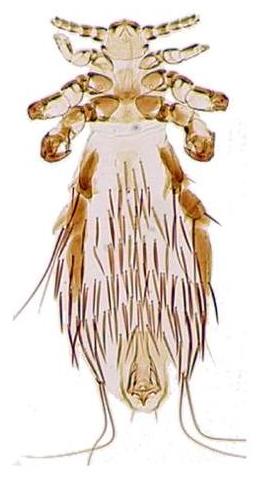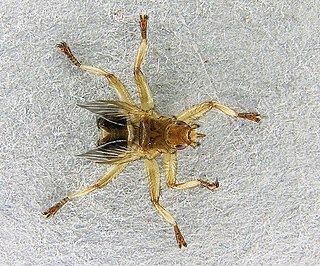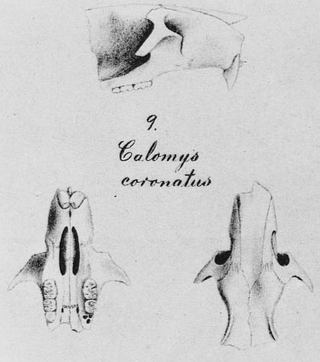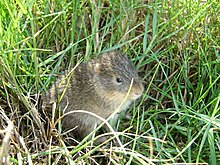
Louse is the common name for any member of the clade Phthiraptera, which contains nearly 5,000 species of wingless parasitic insects. Phthiraptera has variously been recognized as an order, infraorder, or a parvorder, as a result of developments in phylogenetic research.

The guinea pig or domestic guinea pig, also known as the cavy or domestic cavy, is a species of rodent belonging to the genus Cavia in the family Caviidae. Breeders tend to use the name "cavy" for the animal, but "guinea pig" is more commonly used in scientific and laboratory contexts. Despite their name, guinea pigs are not native to Guinea, nor are they closely related to pigs. They originated in the Andes region of South America. Studies based on biochemistry and hybridization suggest they are domesticated animals that do not exist naturally in the wild, descendants of a closely related cavy species such as C. tschudii. They were originally domesticated as livestock for a source of meat, and are still consumed in some parts of the world.

Caviinae is a subfamily uniting all living members of the family Caviidae with the exception of the maras, capybaras, and Kerodon. The subfamily traditionally contained the guinea pig or cavy-like forms along with the cursorially adapted (running) Kerodon. Molecular results suggest the Caviinae as so defined would be paraphyletic and Kerodon is more closely related to maras and capybaras than to other caviines. This led Woods and Kilpatrick (2005) to unite Kerodon and capybaras into the subfamily Hydrochoerinae within the Caviidae. These studies also suggest Microcavia and Cavia are more closely related to one another than either is to Galea.

Menoponidae is a monophyletic family of lice in the superfamily of chewing lice, Amblycera, often referred to as the chicken body louse family. They are ectoparasites of a wide range of birds including chickens, which makes them important to understand for veterinary science and for human health. However, Menoponidae are not exclusive to poultry and are common parasites for migratory birds, with more and more species being discovered every year.

Hippoboscidae, the louse flies or keds, are obligate parasites of mammals and birds. In this family, the winged species can fly at least reasonably well, though others with vestigial or no wings are flightless and highly apomorphic. As usual in their superfamily Hippoboscoidea, most of the larval development takes place within the mother's body, and pupation occurs almost immediately.

Cavia is a genus in the subfamily Caviinae that contains the rodents commonly known as guinea pigs or cavies. The best-known species in this genus is the domestic guinea pig, Cavia porcellus, a meat animal in South America and a common household pet outside of that continent.

The Brazilian guinea pig is a guinea pig species found in Argentina, Brazil, Bolivia, Colombia, Ecuador, Guyana, Paraguay, Uruguay and Venezuela.

The greater guinea pig is a species of rodent found in the coastal strip of Brazil and Uruguay, where it lives in moist grassland and marshes.

Spix's yellow-toothed cavy is a rodent, a cavy species from South America. It is found in Bolivia east of the Andes and much of south central to northeastern Brazil. The species is found in open savanna and semiarid habitats, such as the Cerrado and Caatinga of Brazil. Its karyotype is 2n = 64 and FN = 118.

Euryoryzomys russatus, also known as the russet oryzomys, russet rice rat, or big-headed rice rat, is a species of rodent in the family Cricetidae. It is a member of the genus Euryoryzomys, which was split off from Oryzomys in 2006. It was first described by Johann Andreas Wagner in 1848. It is found in southern Brazil, eastern Paraguay and northeastern Argentina. It is considered a large species in its genus, with a reddish-brown coat, long tail length, and large skull. It is a terrestrial rodent, spending its time foraging for seeds, fruits, and insects. It is listed by the IUCN as least concern, although studies have shown it to be influenced by anthropogenic disturbances. Predators consist of small members of the order Carnivora.

Cavia guianae is a guinea pig species from South America. It is found in southern Venezuela, Guyana, and portions of northern Brazil. Some biologists believe it to be a feral offshoot of the domestic guinea pig, Cavia porcellus; others subsume it under the wild cavy, Cavia aperea. Molecular data collected show there is little genetic differentiation in C.a. guianae known to be a lowland locality in comparison to C. anolaimae which are predominantly highland populations.
The common yellow-toothed cavy is a species of rodent in the family Caviidae, closely related to the domesticated guinea pig. It is found in Argentina, Bolivia, Chile, and Peru. Its karyotype has 2n = 68 and FN = 136. G. musteloides is the most common and widely found member of Galea, and is present at elevations ranging from 20 to 5000 m above sea level. It has yellow teeth.

Leach's single leaf bat, also known as Greater Antillean long-tongued bat, is a species of bat in the family Phyllostomidae. It is found in the southern Bahamas and in all the Greater Antilles. It forms large colonies, with up to a few hundred thousand individuals, and feeds on a relatively wide variety of food items including pollen, nectar, fruit and insects.

Paleoparasitology is the study of parasites from the past, and their interactions with hosts and vectors; it is a subfield of paleontology, the study of living organisms from the past. Some authors define this term more narrowly, as "Paleoparasitology is the study of parasites in archaeological material." K.J. Reinhard suggests that the term "archaeoparasitology" be applied to "... all parasitological remains excavated from archaeological contexts ... derived from human activity" and that "the term 'paleoparasitology' be applied to studies of nonhuman, paleontological material." This article follows Reinhard's suggestion and discusses the protozoan and animal parasites of non-human animals and plants from the past, while those from humans and our hominid ancestors are covered in archaeoparasitology.
Human parasites include various protozoa and worms.

Pseudolynchia canariensis, the pigeon louse fly or pigeon fly, is a species of biting fly in the family of louse flies, Hippoboscidae.

The Muenster yellow-toothed cavy is a species of rodent in the family Caviidae. It is known only from one location in Valle Hermoso in the Bolivian Andes, at an elevation of 2,557 m (8,389 ft). Specimens from this location were shipped to Muenster, Germany, in 1997 for laboratory research, where the species was recognized and described. Galea monasteriensis was recognized on the basis of morphological, behavioral, and reproductive differences from related species. However, its habits in the wild have not been studied.
C. intermedia may refer to:

Spinturnix is a genus of mites in the family Spinturnicidae. Spinturnix mites are an ectoparasite found on species of bats. They live exclusively on the wing and tail membranes and are large enough to be seen with the naked eye. Spinturnix mites are a host specific species, meaning they have a few major host species that they prefer, as well as a few less frequently used hosts. In short, these mites will not infect arbitrary bat species. Their selection of host tends to align with the host species that lives closest to their local environment. Spinturnix mites are found strictly on Microchiroptera. These mites are hematophagous, meaning they feed on the blood of their host. They cannot survive without a host for more than a few hours. Therefore, transmission of mites to other hosts must occur by close contact, such as a bat in a roost.

Galea is a genus of South American rodents of the family Caviidae. 5-6 extant species are known, found in Argentina, Bolivia, Chile, Peru and Brazil. They are:
















